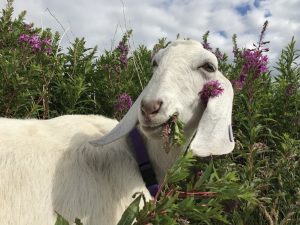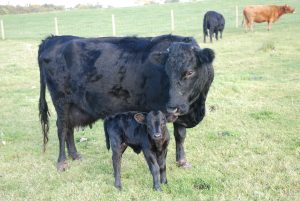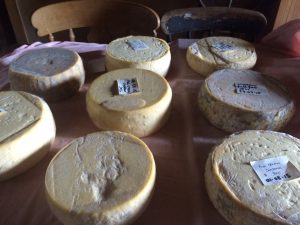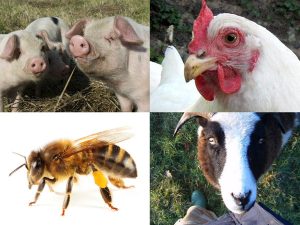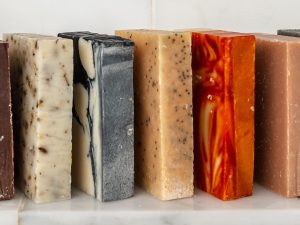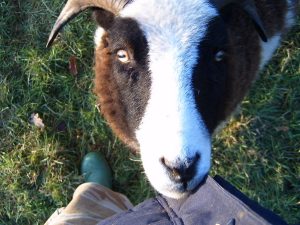Dairying - introduction
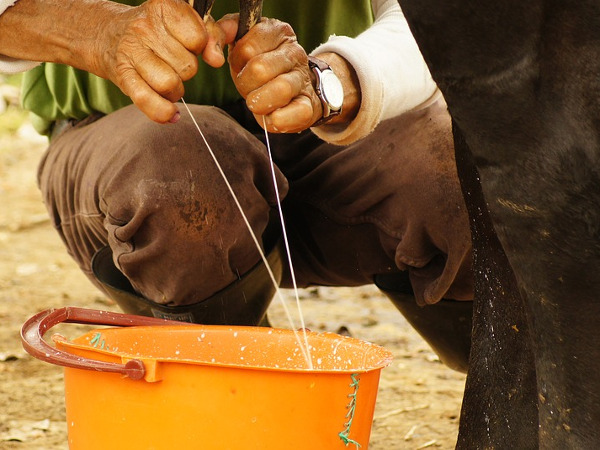
“There is a handful of pioneers now producing more ethical milk and, in one form or another, raising calves on their mothers. It’s a start, and hopefully a trend, that will lead to many more cow-calf dairies popping up around the country in response to demand from a small but growing number of compassionate consumers.” – Christine Page, Smiling Tree Farm
Contents
What is dairying?
Dairying is the production of milk from livestock and may also involve processing the milk into other products. Dairy products include, but are not limited to: milk, cream, ice-cream, butter, cheese, yogurt and soap. The most common dairy animals worldwide are cows, sheep and goats, but horses, buffaloes and camels are also milked. Harvesting milk from animals may have begun as long as 10,000 year ago with nomadic herders, after which it was taken up by the first settled agricultural communities. Today dairying takes place all over the world at all scales, from subsistence farming communities with a few goats to ‘mega-dairies’ of thousands of cows in zero-graze systems.
As dairy farming has become more intensive welfare problems have increased. The drive for higher milk yields particularly has resulted in cows with a shorter productive life and problems with lameness, mastitis and infertility. In modern commercial milk production the young are almost always removed from their mothers hours or, at best, days after birth. Cow-calf dairying is becoming more common, but if we want to see more ethical milk in our shops we will have to be willing to pay more for it. The only type of dairying we advocate is small-scale production with animals who have access to the outdoors and are allowed to raise their own young.

What are the benefits of dairying?
If milk is part of your diet, you can ensure that your milk has been produced in an ethical and sustainable way – that animals are allowed to roam outdoors, have a natural diet and are allowed to remain with their young. You will have the peace of mind of knowing exactly how the milk is produced and how the animals are cared for.
If you keep dairy animals this way, you will be an example of what can be done to produce dairy products in a more ethical and sustainable way. If we want this sort of production to become more widespread, and for its products to be more widely available, we need more people to show it can be done.
As well as the range of products you can obtain from milk, dairy animals can provide other things too: meat, fibre, hides, manure, land clearance, even harness and pack work. Dairy animals can make your smallholding more viable by providing vital additional income if you move into selling your products.

What can I do?
Choose your animal
If you’re thinking about producing your own dairy products, one of the first things you need to consider is which animal will best fit your needs and resources. Your main options are cows, goats and sheep, here we’ll take a brief look at the requirements for each and what you might expect to get in return.
There are some basic questions you should consider to start with. The answers will help guide you as to which option might suit you best:
- How much milk you would like each day?
- What resources (facilities, time and money) do you have to allocate to this goal?
- How much land and what quality of grazing or browsing do you have available?
- Do you have a stable or barn to bring livestock in at night or in the winter if needed?
- Do you like the taste of cow/sheep/goat milk and cheese?
- Most importantly: Do you prefer working with cows or goats or sheep?

Cows: yields described here apply to a low-impact system with little supplementary feeding and once-a-day milking. Cows come in all shapes and sizes, from pure dairy breeds, to dual purpose, all with different milk yields. As a general rule of thumb, if you have good grazing, approximately 2 acres per cow-calf pair, and some decent hay for the winter, then you can expect a cow to give around 4 litres from a once-a-day milking plus raise her own calf without the need for bought-in supplementary feed. Once the calf is weaned you could get up to 8 litres from once-a-day milking on no supplementary feed. However, every cow is different. Cow’s milk is excellent for making cream and butter as the large fat globules mean cream separates easily from the liquid.
You don’t need any special facilities for keeping a cow other than a field for grazing and a shelter for the winter. You do need a bit more space than you would for goats and sheep, and the confidence to handle a larger animal.
More information on keeping cattle.
Goats: there are dairy goat breeds and dual-purpose hybrids which will produce between 2 and 6 litres of milk a day. While a goat is also nursing a kid you can get around half that amount. Goat’s milk is more easily digestible than cow’s milk and contains less lactose; people who find cow’s milk difficult to digest can often tolerate goat’s milk. The smaller fat globules in goat’s milk mean it’s naturally homogenized but it’s also more difficult and time-consuming to make cream and butter from. One possible advantage of goats is that some does from good dairy strains will come into milk without being bred, and some will milk indefinitely after one kid. It’s hard to establish how common this is however, and you would certainly have to be lucky.
Goats need less space and can be kept on rougher land than cows, including land that is steep and rocky. They are not naturally grazers and prefer to browse on trees and shrubs. Unlike cows and sheep, goats do not cope well with damp weather and need access to shelter at all times. They are the easiest to train of the 3 animals discussed here but their intelligence also means they are notorious escape artists and require good fences. Like sheep, you can keep goats which produce milk and fibre as well as goats which produce milk and meat.
More information on keeping goats.

Sheep: sheep produce less milk than goats and cows. The very best dairy breed might produce 3 litres per day and they have a shorter lactation period of around 8 months. As far as we can establish sheep need to be bred every year to produce milk. As with goat’s milk, sheep’s milk is easily digestible, though it does not have the lower lactose content. It is higher in fat, protein and calcium than other milks. The high fat content of sheep’s milk makes it ideal for making cheese, and litre-for-litre you will get more cheese from sheep’s milk than from cow’s or goat’s.
Sheep need a similar amount of space to goats, but have simpler requirements in terms of fencing and housing as they are not escape artists and they don’t mind the rain. They are grazers like cows rather than browsers like goats. They can be flightier and harder to handle than goats, which can also make them trickier to milk, and a stressed sheep means less milk in the bucket.
More information on keeping sheep.
When choosing your animals temperament is paramount. It doesn’t matter nearly so much if her toes point out or her back is swayed as it does that she is easy to handle. She is not going to be put through the stress of a large, intensive dairy system, so many of the ‘rules’ about shape of udder or positioning of teats or length of back are far less important. You are looking for a healthy, sound animal with a calm disposition. Look for a deep body and a healthy udder. You may also want to consider whether her teats are a good size to hand-milk – i.e. not too small.

Breeding
You can usually breed cows and goats every second year to maintain a supply of milk. Goats in particular sometimes go much longer (see above). Sheep are usually bred every year to maintain a milk supply. On a small scale, keeping a bull or a billy goat is often not realistic. Rams are slightly easier to manage and may be worth considering if you have quite a few sheep.
Artificial insemination (AI) is often the most practical option, particularly for cows, which are more costly to transport. Training for AI is widely available and the procedures are not complicated. The process is often less stressful for the animal than a natural mating, particularly when transport and meeting an unknown male are involved. You do, however, need to budget for the possibility of failure and the need to repeat the process (although this is also the case with transport to a breeding male). For goats and sheep, hiring or visting a breeding male is more often the better option, especially if there is one nearby, but bear in mind the paperwork associated with moving animals between holdings.

Milking and hygiene
When your animal has a kid, lamb, or calf at foot you can obtain some milk by preventing the young from nursing overnight. This can be done in such a way that mother and young are not completely separated and can still see each other and have some contact, e.g. in adjacent stalls. When your dairy animal has young at foot you have the flexibility to miss a day’s milking and allow the offspring to take the extra milk.
We’ve published a series of articles about dairying without removing calves from mothers.
Once the young are weaned you need to milk your animals every day without fail, and if you establish a pattern of milking twice a day you need to milk them twice a day every day. In terms of time, someone experienced can hand-milk a cow in around 10 minutes, and less for goats and sheep. Animals can be trained to milk in the field or to come to a shelter to be milked. It’s easier to milk sheep and goats using a milking platform. If animals are receiving supplementary feed they’re often given this during milking.
Milking by hand is not difficult to learn but does involve a specific technique – see the video below. It’s good practice to examine the udder for any injury or sign of infection before you start. Most sources also advise you to ‘strip’ each teat before you begin milking. This involves making 3 or 4 squirts to clear each teat of dirt and bacteria and examine the milk for any sign of infection.
Hygiene is important – your hands and the udder must be clean. The bucket, bottles and any other milk filtering equipment should be sanitised with boiling water. The work involved in sterilising a small milking machine can mean that, for a small number of animals, milking by hand is more efficient and less time-consuming.
If you wish to sell your milk, you will need to have one room for milking and one room for milk processing, away from where your animals are housed. These rooms will need to meet the current hygiene regulations, and will be inspected regularly.
Milk products
Cream: cream is obtained by leaving milk to stand overnight in a large shallow container, heating gently then skimming the cream off. There are accounts of skimming off with a slotted spoon, a ladle and a turkey baster, find the one that works for you! If you’re producing a lot of cream you can purchase separators which use centrifugal force to separate the cream from the milk. Once you have your cream you can make whipped cream, sour cream, ice cream and butter.
Butter: to make butter you need to churn your cream until it separates into buttermilk, which can then be drained off, and butterfat. There are various methods, the most low-tech of which is to place the cream in a bottle or jar with a marble and shake it vigorously. This method is time consuming but good fun if you have a gang of kids to pass it around. If you want to make butter regularly you may want to use an electric hand mixer or a small hand-operated or electric butter churn. Once you have drained off the buttermilk you can press the butter into a block, which is often done using wooden paddles.

Ice-cream: ice-cream is made by heating and mixing your milk, cream, sugar and other ingredients, then freezing. The mixture should be blended once or twice during the freezing process to prevent large ice crystals forming or the cream from separating. Electric domestic ice-cream makers are available.
Yogurt & cultured milk: yogurt is made by adding specific strains of bacteria to your milk, either from a previous batch of yogurt or from a purchased ‘starter’. The milk is then heated and kept warm. This can be done in a thermos flask, an insulated box or a yogurt maker (essentially a very large thermos flask). There are many other fermented milk products you can make using a similar process. Some of these, such as kefir, can be made at room temperature.
Cheese: cheese is an excellent way to preserve milk. The simplest cheeses to start with are soft cheeses. Making soft cheese involves adding a starter and other ingredients to the milk, leaving to stand for 24 hours then draining off the liquid ‘whey’. Hard or semi-hard cheeses are slightly more complicated, involving further heating, then pressing and a maturing process.

Soap: goat’s milk is the milk most commonly used to make creamy soap bars, but other milks can be used too. In any soap making recipe the water can be replaced with milk, although the milk should be chilled or even frozen before the lye is added.
More information on soap making.
If you are wishing to produce milk or other products to sell then you will need to be registered with Trading Standards as a food business. You will be inspected and licensed by the Food Standards Agency, and inspected and approved by your local Environmental Health Officer. There are many rules and regulations that need to be adhered to, procedures and risk analyses to complete and records to keep. Regular milk samples need to be sent for testing, for which there is significant cost. You need to consider the latest food labeling requirements and send samples for shelf-life testing. If you are considering selling milk, then the best thing to do is to first seek advice from your local Environmental Health Officer and the Food Standards Agency.
Specialist(s)
Thanks to Alex Heffron of Mountain Hall Farm for information.
The specialist(s) below will respond to queries on this topic. Please comment in the box at the bottom of the page.

Alex Heffron and his wife Sam started Mountain Hall Farm in the Welsh Preseli Hills without any previous farming experience. They run a micro-dairy selling 100% pasture-fed raw Jersey milk and beef directly to their local community. By using principles of permaculture, holistic management and regenerative agriculture, they bring people together through good food with respect for their animals and nature.

